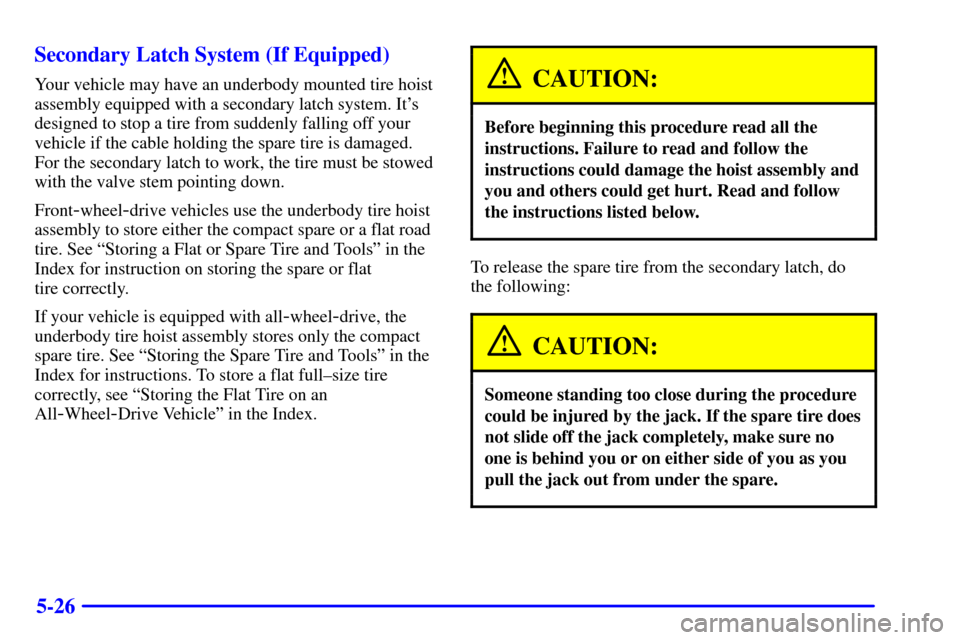Page 344 of 486

5-11
NOTICE:
If your engine catches fire because you keep
driving with no coolant, your vehicle can be
badly damaged. The costly repairs would not be
covered by your warranty. See ªOverheated
Engine Protection Operating Modeº in the Index.
If No Steam Is Coming From Your Engine
If you get an engine overheat warning but see or hear no
steam, the problem may not be too serious. Sometimes
the engine can get a little too hot when you:
�Climb a long hill on a hot day.
�Stop after high
-speed driving.
�Idle for long periods in traffic.
�Tow a trailer.If you get the overheat warning with no sign of steam,
try this for a minute or so:
1. If your air conditioner is on, turn it off.
2. Turn on your heater to full hot at the highest fan
speed and open the window as necessary.
3. If you're in a traffic jam, shift to NEUTRAL (N);
otherwise, shift to the highest gear while
driving
-- AUTOMATIC OVERDRIVE (D)
or THIRD (3).
If you no longer have the overheat warning, you can
drive. Just to be safe, drive slower for about 10 minutes.
If the warning doesn't come back on, you can
drive normally.
If the warning continues, pull over, stop, and park your
vehicle right away.
If there's still no sign of steam, idle the engine for
three minutes while you're parked. If you still have the
warning, turn off the engine and get everyone out of the
vehicle until it cools down. Also, see ªOverheated
Engine Protection Operating Modeº listed previously in
this section.
You may decide not to lift the hood but to get service
help right away.
Page 353 of 486

5-20
9. Then fill the coolant recovery tank to the FULL
COLD mark.
10. Put the cap back on the coolant recovery tank.
If a Tire Goes Flat
It's unusual for a tire to ªblow outº while you're driving,
especially if you maintain your tires properly. If air goes
out of a tire, it's much more likely to leak out slowly.
But if you should ever have a ªblowout,º here are a few
tips about what to expect and what to do:
If a front tire fails, the flat tire will create a drag that
pulls the vehicle toward that side. Take your foot off the
accelerator pedal and grip the steering wheel firmly.
Steer to maintain lane position, and then gently brake to
a stop well out of the traffic lane.
A rear blowout, particularly on a curve, acts much like a
skid and may require the same correction you'd use in a
skid. In any rear blowout, remove your foot from the
accelerator pedal. Get the vehicle under control by
steering the way you want the vehicle to go. It may be
very bumpy and noisy, but you can still steer. Gently
brake to a stop
-- well off the road if possible.
If a tire goes flat, the next part shows how to use your
jacking equipment to change a flat tire safely.
Page 357 of 486

5-24
3. To remove the compact spare tire from the cable, tilt
the retainer at the end of the cable so it can be pulled
up through the wheel opening.4. If your vehicle is an all
-wheel-drive vehicle, after
removing the compact spare tire turn the wrench
clockwise to raise the cable back up.
On and AWD vehicle, you can not store a full
-size
tire under the vehicle. It should be stowed inside
the vehicle by the cable provided. See ªStoring the
Flat Tire on an All
-Wheel-Drive Vehicleº later in
this section.
If you have a front
-wheel-drive vehicle, the hoist is
used to store a full
-size or a flat road tire under the
vehicle. See ªStoring the Spare Tire and Toolsº and
ªStoring the Flat Tire on a Front
-Wheel-Drive
Vehicleº later in this section.
If the compact spare tire will not lower, check under the
vehicle to see if the tire is hanging loose and the cable
end and spring under the wheel plate are missing. If so
the secondary latch system is engaged. See ªSecondary
Latch Systemº later in this section.
To continue changing the flat tire see ªRemoving
the Flat Tire and Installing the Spare Tireº later in
this section.
Page 359 of 486

5-26 Secondary Latch System (If Equipped)
Your vehicle may have an underbody mounted tire hoist
assembly equipped with a secondary latch system. It's
designed to stop a tire from suddenly falling off your
vehicle if the cable holding the spare tire is damaged.
For the secondary latch to work, the tire must be stowed
with the valve stem pointing down.
Front
-wheel-drive vehicles use the underbody tire hoist
assembly to store either the compact spare or a flat road
tire. See ªStoring a Flat or Spare Tire and Toolsº in the
Index for instruction on storing the spare or flat
tire correctly.
If your vehicle is equipped with all
-wheel-drive, the
underbody tire hoist assembly stores only the compact
spare tire. See ªStoring the Spare Tire and Toolsº in the
Index for instructions. To store a flat full±size tire
correctly, see ªStoring the Flat Tire on an
All
-Wheel-Drive Vehicleº in the Index.
CAUTION:
Before beginning this procedure read all the
instructions. Failure to read and follow the
instructions could damage the hoist assembly and
you and others could get hurt. Read and follow
the instructions listed below.
To release the spare tire from the secondary latch, do
the following:
CAUTION:
Someone standing too close during the procedure
could be injured by the jack. If the spare tire does
not slide off the jack completely, make sure no
one is behind you or on either side of you as you
pull the jack out from under the spare.
Page 363 of 486
5-30
3. Attach the folding
wrench to the jack, and
turn the wrench
clockwise to raise the
jack head a few inches.
4. Raise the vehicle by turning the folding wrench
clockwise in the jack. Raise the vehicle far enough
off the ground so there is enough room for the
compact spare tire to fit under the wheel well.
5. Remove all the wheel nuts and take off the flat tire.6. Remove any rust or dirt
from the wheel bolts,
mounting surfaces and
spare wheel.
CAUTION:
Rust or dirt on the wheel, or on the parts to
which it is fastened, can make the wheel nuts
become loose after a time. The wheel could come
off and cause an accident. When you change a
wheel, remove any rust or dirt from the places
where the wheel attaches to the vehicle. In an
emergency, you can use a cloth or a paper towel
to do this; but be sure to use a scraper or wire
brush later, if you need to, to get all the rust or
dirt off.
Page 364 of 486
5-31
CAUTION:
Never use oil or grease on studs or nuts. If you
do, the nuts might come loose. Your wheel could
fall off, causing a serious accident.
7. Install the compact spare tire and put the wheel nuts
back on with the rounded end of the nuts toward the
wheel. Tighten each nut by hand until the wheel is
held against the hub.
8. Lower the vehicle by attaching the folding wheel
wrench to the jack and turning the wrench
counterclockwise. Lower the jack completely.
Page 367 of 486

5-34
Storing the Spare Tire and Tools
1. Lay the tire near the rear of the vehicle with the
valve stem down.
2. If the vehicle has aluminum wheels, remove the
small center cap by tapping the back of the cap with
the extension of the shaft.
3. Slide the cable retainer through the center of the
wheel and start to raise the tire.
Make sure the retainer is fully seated across the
underside of the wheel.
4. When the tire is almost in the stored position,
turn the tire so the valve is towards the rear of
the vehicle.
This will help when you check and maintain tire
pressure in the spare.
5. Raise the tire fully against the underside of the
vehicle. Continue turning the folding wrench until
you feel more than two clicks. This indicates that the
compact spare tire is secure and the cable is tight.
The spare tire hoist cannot be overtightened.
6. Make sure the tire is stored securely. Push, pull, and
then try to rotate or turn the tire. If the tire moves,
use the folding wrench to tighten the cable.
Put back all jacking tools as they were stored in the jack
storage compartment and put the compartment cover
back on.
To put the cover back on, line up the tabs on the right of
the cover with the slots in the cover opening. Push the
cover in place and push down the tab so that it rests in
the groove. This secures the cover in place.
Page 368 of 486
5-35
A. Strap
B. Bag and Tools
C. Jack
Unless you have the plastic ªbolt
-onº wheel covers, be
sure to also store the center cap. When you replace the
compact spare with a full
-size tire, reinstall the bolt-on
wheel covers and the center cap. Tighten them ªhand
tightº over the wheel nuts, using the folding wrench.Storing the Flat Tire on a Front
-Wheel-Drive Vehicle
Follow the procedure for storing a spare tire
listed previously.
Storing the Flat Tire on an All
-Wheel-Drive Vehicle
1. Remove the tire storage bag and cable package from
the jack storage area
2. If the vehicle has aluminum wheels, remove the
small center cap by tapping the back of the cap with
the extension of the shaft.
3. Put the flat tire in the tire storage bag and place it in
the rear storage area with the valve stem pointing
toward the front of the vehicle.